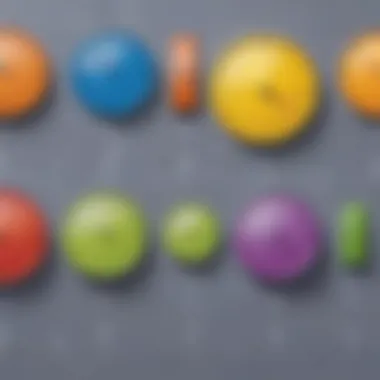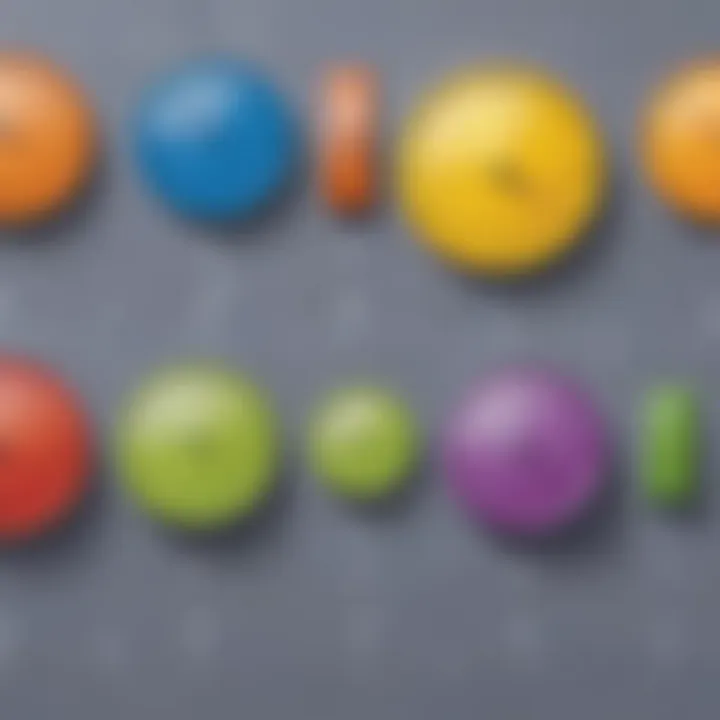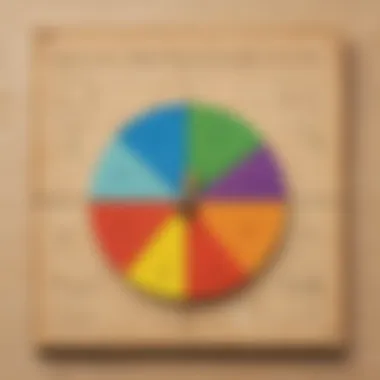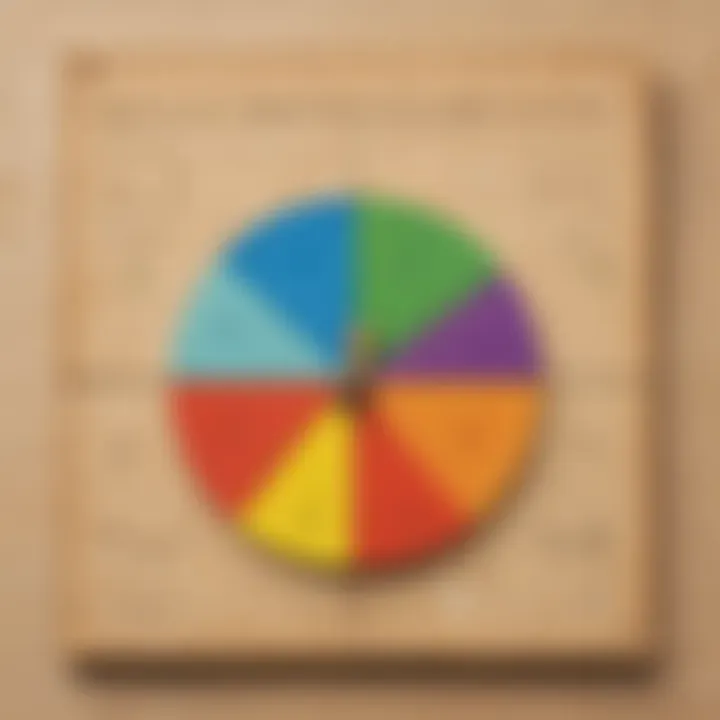Mastering Benchmark Fractions for Young Learners


Intro
Benchmark fractions play a vital role in helping students grasp complex fraction concepts. Their simplicity makes them approachable for young learners. Understanding these fractions fosters important skills in comparison, estimation, and problem-solving. This guide aims to shed light on the effective use of benchmark fractions and how they can be incorporated into educational practices, catering specifically to elementary school students.
Creative Activities
Engaging students through creative activities is an excellent way to solidify their understanding of benchmark fractions.
Craft Ideas
Craft activities allow students to visualize fractions. Consider making fraction wheels or fraction cards. These hands-on projects help children see the relationships between different fractions, enhancing their learning experience.
Step-by-Step Guides
- Fraction Wheel:
- Fraction Cards:
- Gather materials: paper plates, scissors, markers.
- Cut the plate into equal parts to represent fractions.
- Label each section with benchmark fractions like 1/2, 1/4, and 3/4.
- Let children color each section to make it visually appealing.
- Use cardstock paper and cut it into small rectangles.
- Write different fractions on each card, including benchmark ones.
- They can use these cards for matching games.
Educational Value
These activities not only engage students but also develop their ability to recognize and use benchmark fractions visually. By creating their own materials, children take ownership of their learning, which can enhance retention and understanding.
Fun Quizzes
Quizzes are a powerful tool for reinforcing what has been taught about benchmark fractions. They offer a way to assess understanding in a fun manner.
Quiz Topics
Possible quiz topics include:
- Identifying benchmark fractions.
- Comparing fractions using benchmark fractions.
- Estimating sums and differences of fractions.
Question Types
The quizzes can contain a variety of question types, such as:
- Multiple choice: Ask students to select the correct benchmark fraction.
- Fill in the blanks: Students fill in missing benchmark fractions in given problems.
- True or false: Statements about benchmark fractions can be evaluated.
Knowledge Reinforcement
Taking quizzes enables learners to apply their knowledge practically. Moreover, the process of answering questions helps strengthen memory and understanding while providing immediate feedback.
Fact-Based Articles
Reading about benchmark fractions can further enhance students' learning.


Topics
Fact-based articles may cover a variety of relevant topics, such as:
- The importance of fractions in everyday life.
- Historical insights into how fractions were developed.
- Practical applications of fractions in various fields.
Engaging Content
These articles should present clear information through simple language. Use visuals and examples to maintain interest. Articles that are engaging often hold a child’s attention better and encourage exploration.
Foreword to Benchmark Fractions
Benchmark fractions are essential in mathematics, especially when dealing with comparisons and estimations. Understanding these fractions helps students grasp concepts more easily. Instead of memorizing complex fractions, they can use benchmark fractions as reference points. This simplifies learning and enhances confidence in mathematical reasoning.
The use of benchmark fractions paves the way for a clearer understanding of fractions as a whole. Without a solid grasp of these basic fractions, students may struggle to proceed to more advanced topics. Teaching benchmark fractions at an early stage strengthens their computational skills and allows them to solve problems efficiently. This section will lay the foundation for delving deeper into the definition and purpose of benchmark fractions, setting the stage for practical applications to come.
Key Benchmark Fractions
Key benchmark fractions serve a fundamental role in understanding mathematics, especially for young learners. They simplify the process of learning fractions by establishing easily recognizable reference points. This section explores common benchmark fractions, noting their unique characteristics and practical applications in various contexts.
Common Benchmark Fractions
One half
One half, represented as 1/2, is perhaps the most prevalent benchmark fraction. It divides a whole into two equal parts. Its significance lies in its simplicity and its frequent appearance in everyday situations. For instance, if a pizza is shared between two people, each person receives one half of the pizza. The ability to quickly identify that one half is equivalent to 0.5 or 50% aids in various calculations and comparisons.
The appeal of one half is clear. It is a perfect example of an equal division and serves as a foundational concept when introducing students to fractions. One half provides clarity in understanding both larger and smaller fractions. However, its limitation is that it does not represent fractions that are closer to whole numbers or those that exceed a single whole.
One fourth
One fourth, denoted as 1/4, represents a quarter of a whole. It is essential in both educational settings and practical use. When a cake is cut into four equal pieces, one fourth signifies one piece. This fraction becomes particularly useful when dividing things into smaller, manageable units.
The key characteristic of one fourth is its straightforwardness. It bridges the gap between one half and smaller fractions like one eighth. This fraction is beneficial for estimation processes, as it aids children in visualizing how much one fourth of something encompasses. The challenge with one fourth is that its numeric representation (0.25) might not always be as intuitive as whole numbers or more substantial fractions.
Three fourths
Three fourths, or 3/4, is significant in fraction discussions since it reflects a substantial part of a whole. If a pizza cut into four pieces has three pieces remaining, that is three fourths of the pizza left. It plays a major role in contexts where slight adjustments to quantities are needed.
This fraction's primary advantage is that it helps convey concepts of more than half but not fully complete. It represents a precise fraction that encourages thoughtful estimations. On the downside, three fourths can create confusion when students are required to subtract or compare against whole numbers, especially if they only have experience with comparing halves.
One third
One third, depicted as 1/3, divides a whole into three equal parts. This fraction is crucial in situations where items need to be equally distributed among three recipients. For example, if three friends are sharing a sandwich, each friend gets one third of it.
The main appeal of one third is its ability to introduce concepts of division and equality in a straightforward manner. Its representation as approximately 0.33 makes it relatable when working with decimals. However, one third can become challenging in applications that utilize larger numbers or when mixed with other fractions, causing potential confusion.
Fractions Greater than One


Fractions greater than one illustrate values that exceed a complete unit. For instance, with improper fractions like 5/4 or 2/1, learners begin to grasp the idea that fractions can represent quantities larger than whole numbers. The understanding of these large fractions is essential in shifting a student's perspective on how numbers operate beyond mere whole quantities. In summary, incorporating fractions greater than one into learning extends the comprehension of fractions as versatile tools in mathematics.
Applications of Benchmark Fractions
Benchmark fractions serve as fundamental tools in mathematical reasoning. These fractions act as reference points, enabling students to make sense of more complex fraction concepts. They simplify calculations, enhance estimation skills, and facilitate comparisons. Understanding their applications empowers learners to grasp fractions with greater ease.
Estimating Sums of Fractions
Estimating sums of fractions is a valuable skill that allows students to quickly assess the approximate total of multiple fractions. When adding fractions, students can often find it challenging to combine them. However, using benchmark fractions simplifies this process. For example, if a student wants to add ( \frac14 + \frac13 ), they can think of these fractions in terms of benchmarks.
They might approximate ( \frac14 ) as ( \frac12 ) and ( \frac13 ) as ( \frac12 ). The sum, in this case, can be estimated as ( \frac12 + \frac12 = 1 ). This method helps learners avoid complex calculations and improves their overall confidence.
To effectively estimate sums, teachers can encourage students to visualize fractions on a number line or fraction circles. This visual representation reinforces the concept of benchmark fractions and provides a clearer understanding.
Comparing Fractions
Comparing fractions is another essential application of benchmark fractions. Many students struggle with determining which fraction is larger or smaller. Benchmark fractions, such as ( \frac12 ) or ( \frac34 ), provide easy reference points.
For instance, when comparing ( \frac25 ) and ( \frac38 ), students can use ( \frac12 ) as a benchmark. They can reason that both fractions are less than one half. Next, they may compare how much less they are than one half which can help in understanding their relative sizes. By establishing a frame of reference, students can make more informed comparisons.
Real-world Applications
Benchmark fractions find numerous practical applications in real-world scenarios. They are often used in cooking, budgeting, and measuring. For instance, when cooking, a recipe may call for ( \frac34 ) of a cup of sugar. If a student knows that ( \frac34 ) is close to three fourths of a cup, they can measure accurately and efficiently.
Furthermore, in budgeting, if someone is trying to save money, they can use benchmark fractions to divide up their budget into categories. Knowing that ( \frac12 ) of their budget should go to necessities and the remaining to savings can help in financial planning. This real-world context makes benchmark fractions not just academic tools but also valuable for everyday life.
Strategies to Teach Benchmark Fractions
Teaching benchmark fractions effectively is crucial for developing a solid foundation in mathematics, especially for elementary school learners. Benchmark fractions help students understand proportion and division concepts in real-world situations. By using strategies that engage young minds, educators can enhance understanding and retention of these fractions. This section will outline specific methods, focusing primarily on visual aids and hands-on activities, that teachers and caregivers can employ to facilitate learning.
Using Visual Aids
Visual aids play a significant role in teaching benchmark fractions. They offer tangible representations that help students visualize mathematical concepts. Two useful forms of visual aids are fraction charts and pie diagrams.
Fraction charts
Fraction charts are effective tools that display different fractions alongside benchmark fractions. They clearly present relationships between various fractions. The key characteristic of a fraction chart is its ability to show multiple fractions together, making comparisons straightforward. This visual support aids students in grasping the concept of how fractions relate to each other, thus benefiting their overall understanding of benchmark fractions.
A unique feature of fraction charts is their layered structure, where fractions are often displayed in ascending or descending order. This structure allows students to see which fractions are smaller or larger than benchmark fractions like one half or one fourth. The advantage of using fraction charts is that they simplify complex ideas. However, a disadvantage could be that some students find them overwhelming if too many fractions are presented at once.
Pie diagrams
Pie diagrams, also known as circle graphs, provide another engaging visual representation of fractions. They split a circle into slices, representing different fractions of a whole. The key characteristic of pie diagrams is their circular shape, which effectively conveys how different fractions contribute to a complete entity. This makes them a popular choice for teaching benchmarks like three fourths.
The unique feature of pie diagrams is their ability to present fractions in intuitive ways. Students can see the parts of a whole visually, which reinforces their understanding. One advantage of using pie diagrams is that they make it easy to compare fractions, as viewers can quickly assess the size of each slice relative to the whole. However, pie diagrams can be misleading for students if they do not understand proportionality, which can lead to misconceptions.
Incorporating Hands-On Activities


Hands-on activities enhance learning by allowing students to actively participate in their education. Two effective methods for teaching benchmark fractions are through fraction games and cooking measurements.
Fraction games
Fraction games engage students while helping them understand fractions in a fun environment. The key characteristic of fraction games is that they turn learning into an enjoyable activity. Games can be tailored to various levels of complexity, making them an inclusive option for different learners.
A unique feature of fraction games is their competitive aspect. This encourages students to think critically and apply their fraction knowledge in real-time. The advantage of fraction games is that they promote engagement and memorization through active participation. However, a potential disadvantage is that competition might overwhelm some students, leading to frustration rather than learning.
Cooking measurements
Incorporating cooking measurements into lessons is a practical way to teach benchmark fractions. Cooking requires precise measurements, allowing children to see real-world applications of fractions. The key characteristic of this method is its relevance to everyday life, thus making fractions relatable.
A unique feature of cooking measurements is the use of measuring cups and spoons, which visually represent fractions. Students can directly see how different measurements come together to form a whole recipe. The advantage of this approach is that it fosters a deeper understanding of fractions through practical application. Conversely, a disadvantage could be that some students may lack interest in cooking, making the activity less engaging for them.
In summary, various strategies can effectively teach benchmark fractions. By incorporating visual aids and hands-on activities, educators can create an engaging learning environment. This not only enhances understanding but also makes mathematics enjoyable for young students.
Challenges in Understanding Benchmark Fractions
Understanding benchmark fractions presents certain challenges for both students and educators. These challenges can hinder the learning process. It is essential to identify and address these obstacles to enhance comprehension and mastery of fractions. Recognizing common misconceptions can lead to better strategies for teaching and learning this critical mathematical concept.
Common Misconceptions
Many students come across various misconceptions that may impede their understanding of benchmark fractions. These include:
- Fraction Value Confusion: Some learners may think that all fractions with similar numerators or denominators have the same value. For instance, 1/2 and 2/4 might not be recognized as equivalent. This confusion is especially pronounced with benchmark fractions, where comparisons are crucial for estimation.
- Ignoring the Importance of Whole Numbers: Another prevalent misconception involves failing to relate benchmark fractions to whole numbers effectively. Students often see fractions in isolation without understanding their place within the number line. This can lead to a conceptual gap in their understanding of how fractions function with whole numbers.
- Overemphasis on Procedures: Some learners may focus solely on computational procedures without grasping the concept itself. For instance, remembering to compute 3/4 of a number may be prioritized over estimating that 3/4 is close to a whole number. Hence, this can lead to errors in estimation and application of fractions in real-life situations.
- Misunderstanding the Term "Benchmark": Students sometimes have trouble comprehending what benchmark actually means. If they do not realize benchmark fractions serve as reference points, they may not appreciate their utility in estimation and comparison.
Strategies for Overcoming Challenges
To tackle these challenges, educators can implement effective strategies that foster a clearer understanding of benchmark fractions. Some useful approaches include:
- Concrete Examples: Teachers should provide relatable examples when introducing benchmark fractions. Using visuals, such as counters or fraction pieces, can help learners grasp the concept more concretely. For instance, one could demonstrate that one half can be visually represented in real-life objects like pizza slices.
- Number Line Activities: Engaging students in activities that involve number lines can deepen their understanding of fractions' relationships. By marking the benchmark fractions on a number line, students can visualize how 1/4, 1/2, and 3/4 interact with whole numbers and each other.
- Encourage Estimation Practices: Integrating estimation exercises into lessons can help students acknowledge the significance of benchmark fractions. Practicing mental math by estimating fractions in practical scenarios enhances their ability to use benchmarks effectively.
- Discussion of Misconceptions: Addressing common misconceptions openly in the classroom fosters a better learning environment. Encouraging questions about fractional concepts can help clarify misunderstandings and promote dialogue among students.
- Interactive Learning: Hands-on activities, such as cooking or measuring ingredients, can serve as a practical application of fractions. These activities provide opportunities for students to use benchmark fractions in real-life contexts, reinforcing their relevance and utility.
Understanding benchmark fractions is essential, yet many students face obstacles. Recognizing misconceptions and employing clear strategies can enhance learning outcomes.
By implementing these strategic approaches, educators can facilitate a deeper understanding of benchmark fractions. This foundational knowledge will trigger students' confidence in comparing and estimating fractions effectively.
Closure and Recap
Benchmark fractions are essential tools that facilitate the learning and understanding of mathematical concepts, particularly in elementary education. The conclusion of this article emphasizes how benchmark fractions contribute not only to mastery in basic arithmetic but also to building a solid foundation for future mathematical learning. As students progress, the comprehension of these fractions helps them make sense of more complex concepts such as ratios, proportions, and even algebraic expressions.
Summary of Key Points
In this article, several important aspects of benchmark fractions have been discussed:
- Definition: A benchmark fraction is a common fraction that is used for estimation and comparison. Familiar fractions like one half, one fourth, and three fourths serve as references for understanding other fractions.
- Purpose: Benchmark fractions help students estimate sums and differences involving fractions, making it easier to grasp larger mathematical ideas without extensive calculations.
- Applications: These fractions are vital for real-world problem-solving. They allow for quicker assessments in cooking recipes, budgeting, and other daily activities where fractions are prevalent.
- Teaching Strategies: Effective methods for teaching benchmark fractions include visual aids like charts and hands-on activities such as games that promote interaction and engagement.
- Challenges: Common misconceptions regarding fractions can impede learning. Acknowledging these challenges and employing strategic teaching methods is crucial for overcoming them.
Importance of Benchmark Fractions in Learning
Recognizing the significance of benchmark fractions is critical in the educational journey of young learners. They offer multiple benefits that extend beyond the mere understanding of fractions:
- Enhanced Estimation Skills: Benchmark fractions are particularly beneficial in developing estimation skills. Students learn to make quick approximations, which builds confidence in their mathematical abilities.
- Better Comparisons: With benchmark fractions, students can easily compare different fractions, understanding which is larger or smaller without having to calculate every time.
- Real-world Relevance: Integrating benchmark fractions into practical scenarios makes math more relatable and comprehensible. Students can see the practical uses, which enhances their motivation to learn.
Through the exploration of benchmark fractions, educators and parents can help children engage with math in a meaningful way. This brings forth an understanding that lasts throughout their educational journey and daily life, making math not just a subject to learn, but a tool that offers valuable insights and solutions.







